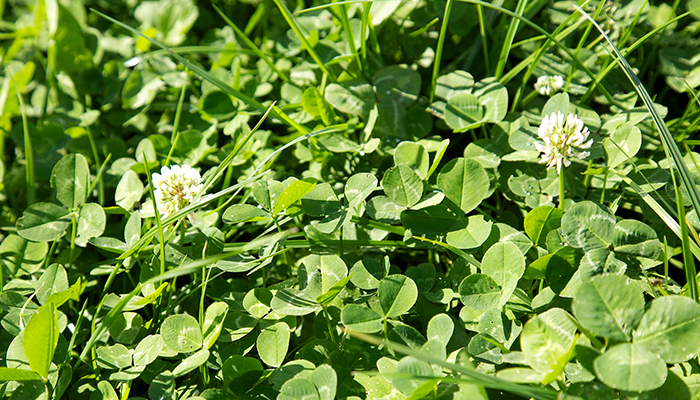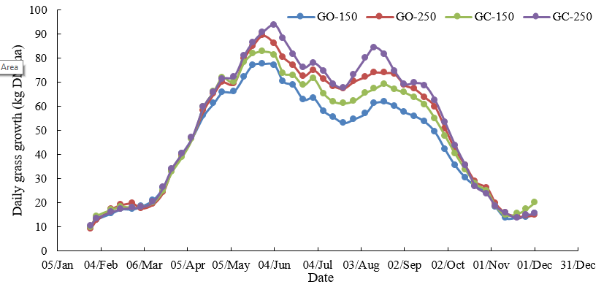25 November 2021
The effect of sward type & nitrogen fertiliser application rate on milk & herbage production

There is renewed interest in the use of white clover in grazing systems due to its ability to biologically fix nitrogen (N). Brian McCarthy, Áine Murray and Fergal Coughlan, Teagasc, look into the effect of sward type and nitrogen fertiliser application rate on milk and herbage production.
Introduction
There is renewed interest in the use of white clover in grazing systems due to its ability to biologically fix nitrogen (N) making it available for plant growth, increase herbage nutritive value and improve animal performance. Research into white clover has been ongoing at Clonakilty Agricultural College since 2012. The first experiment at Clonakilty, which ran from 2014-2017, achieved high sward white clover contents and found large increases in milk and grass production for perennial ryegrass (PRG)-white clover compared to PRG-only swards. This paper will present the results of the new Clonakilty Agricultural College research experiment from 2019-2021. The experiment entitled “The effect of sward type (grass-only vs. grass-clover) and N fertiliser level (150 vs. 250 kg N/ha) on the productivity of spring milk production systems” is investigating how reducing N fertiliser application levels on PRG-only and PRG-clover swards will effect grass and milk production.
Clonakilty experiment 2019-2021
Four separate grazing treatments were utilised for this experiment; a PRG-only sward receiving 150 kg N/ha (GO-150), a PRG-only sward receiving 250 kg N/ha (GO-250), a PRG-white clover sward receiving 150 kg N/ha (GC-150) and PRG-white clover sward receiving 250 kg N/ha (GC-250). There was a separate farmlet of 20 paddocks for each treatment. There were 30 cows in each treatment group, stocked at 2.75 cows/ha and target concentrate supplementation was 450 kg/cow for each treatment. In the previous experiment at Clonakilty from 2014-2017, sward white clover content declined over time due to a number of factors, including high fertiliser N use, silage and grazing management. However, little work was undertaken during the experiment to try to increase sward white clover content by either over-sowing or reseeding swards. As part of the new experiment, a programme of reseeding and over-sowing was undertaken to increase sward white clover content at Clonakilty. In 2019, 20% of the farm was reseeded and in 2020 15% of the farm was reseeded. Additionally, approximately 20-30% of the farm was over-sown with white clover each year.
Results 2019–2021
Sward white clover content increased in 2019 (13.8%) and 2020 (16.4%) from the low levels (<10%) achieved in 2018, however there was a difference between fertiliser rates. The GC-150 treatment had greater sward white clover content (14.4% and 19.1%, in 2019 and 2020, respectively) than the GC-250 treatment (11.1% and 13.6%, in 2019 and 2020, respectively). In 2021 to-date, sward white clover content is 20.5% and 18.2% for the PRG-white clover 150 kg N/ha and PRG-white clover 250 kg N/ha treatments, respectively. Both sward type and N fertiliser rate had an effect on grass DM production (Table 1). Perennial ryegrass-only swards grew 14.5 t DM/ha compared to PRG-white clover swards, which grew 15.1 t DM/ha and there was a 1.26 t DM ha difference between swards receiving 150 kg N/ha or 250 kg N/ha. The PRG-white clover 150 kg N/ha treatment produced an extra 0.8 t DM/ha compared to the PRG-only 150 kg N/ha treatment but produced 0.6 t DM/ha less than the PRG-only 250 kg N/ha treatment. The differences in grass growth occurred during the main grazing season and are illustrated in Figure 1. Due to the lower total grass DM production on the 150 kg N/ha treatments, silage fed during lactation was greater for these treatments compared to the 250 kg N/ha treatments. Silage produced was also below target for all treatments on average over the two years but was lower for 150 kg N/ha treatments. When silage fed during lactation is accounted for the 150 kg N/ha treatments only made 49% of their winter-feed requirement compared to 70% for the 250 kg N/ha treatments. Nitrogen fertiliser rate did not affect milk production but sward type had a significant effect. Cows grazing PRG-white clover swards produced 5,861 kg milk compared to 5,499 kg for cows grazing PRG-only swards, with similar fat and protein contents resulting in cows grazing PRG-white clover swards producing 495 kg milk solids compared to 465 kg for cows grazing PRG-only swards.
Table 1: The effect of sward type and fertiliser rate on herbage and milk production from 2019-2021 (data from 2021 is provisional and is only up to 1st of November)

1GO-150 = perennial ryegrass (PRG)-only sward receiving 150 kg N/ha, GO-250 = PRG-only sward receiving 250 kg N/ha, GC-150 = PRG-white clover sward receiving 150 kg N/ha, GC-250 = PRG-white clover sward receiving 250 kg N/ha; 2Silage deficit based on a winter silage requirement of 1,200 kg DM/cow (4-month winter)
Figure 1: The effect of sward type and fertiliser rate (GO-150 = perennial ryegrass (PRG)-only sward receiving 150 kg N/ha, GO-250 = PRG-only sward receiving 250 kg N/ha, GC-150 = PRG-white clover sward receiving 150 kg N/ha, GC-250 = PRG-white clover sward receiving 250 kg N/ha) on 3-week rolling average daily grass growth

Conclusion
Perennial ryegrass-white clover swards continue to show benefits in terms of milk and milk solids production. This milk response was evident compared to PRG-only swards even at lower sward white clover contents than those observed in previous experiments. Sward white clover content increased during the experiment due to a combination of reseeding and over-sowing. In terms of grass production, sward white clover content was likely not high enough on the GC-150 treatment to fully offset the 100 kg reduction in N fertiliser compared to the GO-250 treatment; however, the GC-150 treatment still produced 96% of the total grass DM production of the GO-250 treatment. The results observed are similar to the Moorepark white clover experiment (2013-2020), although in that experiment the PRG-white clover 150 kg N/ha treatment produced the same amount of total grass DM as the PRG-only 250 kg N/ha treatment (13.5 t DM/ha). Sward white clover content on the PRG-white clover 150 kg N/ha treatment in the Moorepark experiment was 22% on average over the time period of this experiment. The results from both experiments show that white clover will continue to play an important role in facilitating reductions in N use on dairy farms.
This article was produced as part of the two-day Teagasc Virtual Dairy Conference 2021 which took place this week.
The complete Dairy Conference Proceedings will be published on www.teagasc.ie And the individual articles will be published on Teagasc Daily throughput the week. See more at Dairy Conference
